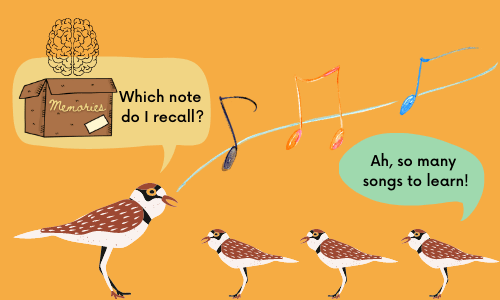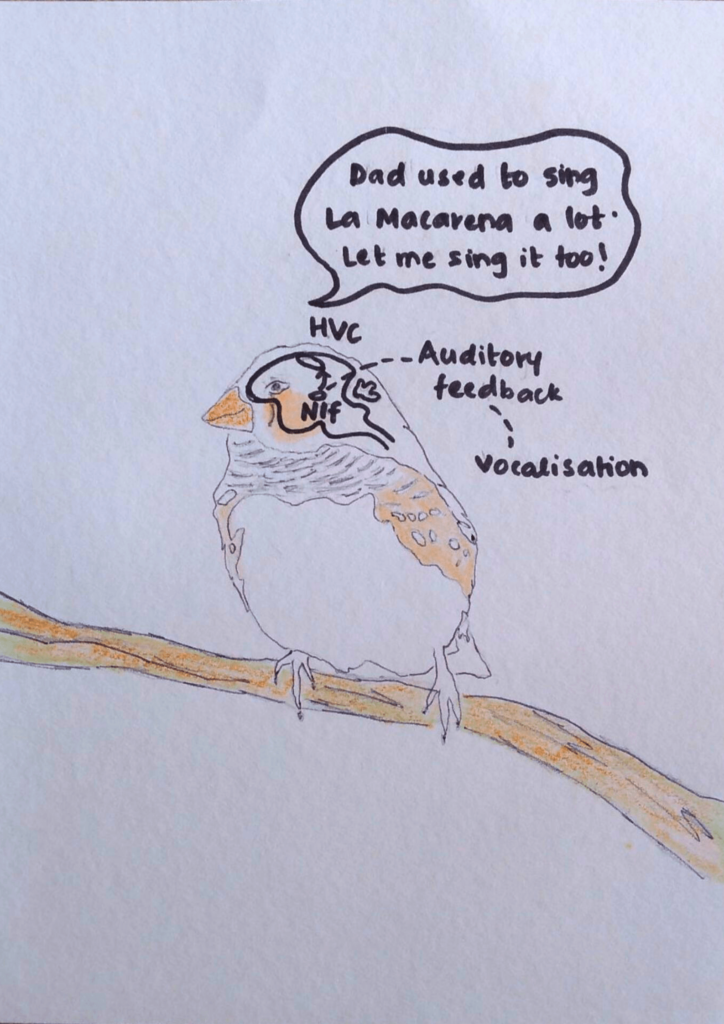Retaining memories and using them to row your brain boat is not just an inherent quality that we possess, but also a life skill that pushes us away from a lit fire. We are tuned in to associate every and any incident with an event that has happened in the past. When one comes to think of it, how are these memories encoded in the brain?
Human brain is a complex structure that has made neuroscientists stop and recompute methods in which they could study it. Enter songbirds. An extensively studied model, songbirds have been observed to have definite memory circuits that teach them how to sing a song by categorizing it into different patterns locked in their memory. Song learning technique observed in zebra finches is very similar to speech acquisition in humans.
Zebra finches, songbirds which are commonly studied to understand how the neural network in their brain functions, memorize songs that have been taught to them and reproduce them by recalling the notes from their recollection. Even though the process of perfecting the song by simply learning it based on songbird’s memory takes a long time, researchers have been able to pinpoint different circuits in zebra finches’ brain that encodes the memory of the songs that they have heard before.
In a zebra finch brain, the auditory system recognizes the song and the motor system nudges the body to reproduce the tune. These two systems work in tandem to produce songs based on the memory reserved in the brain. These birds learn songs from their male parents in two phases:
- Memorization phase, a period in which young male songbirds are tutored by their male parent and the young birds form a neural template of the tune taught to them;
- Sensorimotor phase, a phase in which the young birds reproduce the song in their own vocal output once they match it to the template stored in their memory.
This ‘song system’ helps the bird in perceiving and then producing bits of their memories. Female zebra finches cannot sing; however, they can learn the features of the songs sung by their father and create a preferential version of new songs heard around.

The auditory system and the motor system are connected by a pathway that starts at the nucleus interface (NIf), a small auditory part of the brain, and ends at the high vocal center (HVC), a motor area of the brain. This pathway relays the information extracted from the memory. The HVC is the most important motor region of the brain, and it can affect the ability to learn new songs. Since HVC is connected to Nif, it receives neurons from Nif. These neurons are activated at the beginning and the end of the syllables. This points out that the neuronal activity is somehow correlated to the duration for which the bird will sing a song.

Caudomedial Nidopallium (NCM) and Caudomedial Mesopallium (CMM) are two regions that lie outside the song system yet show neuronal activation when they are introduced to a song. Neuronal activation, or neural activation, is a chain effect seen in the neurons that are charged due to neighboring neurons, subsequently passing on their impulse to the next one. In NCM, the neuronal activation is greatly dependent on how well the bird has learnt a particular song. Neuronal activation is greater in males that are tutored as a juvenile compared to birds that are not tutored when they are young. When females were exposed to songs that they had never sung but were familiar with since they were raised by a complete set of parents, the CMM showed significant neuronal activation.
Essentially, songbirds, be tutored or non-tutored, have the ability to connect the notes when they are re-exposed to an old song or introduced to a new one. When re-exposed to a new song, they have the capacity to access their memory and reproduce the tune that they had learnt earlier, while they have the ability to fit the new song in their neural template and churn out a vocal output solely based on the notes locked in their memory.
Well, now we know that songbirds are insanely talented vocalists that rely on their memories to give a stellar performance. What would happen to their musical show if we were to tweak their database by implanting new memories in their brain?
Todd Roberts and team at the University of Texas Southwestern Medical Center manipulated a region of the song system to investigate if there was a change in the notes sung by the birds and the duration for which they continued singing a song. To check the same, Roberts used optogenetics, a technique where the neural activity between HVC and NIf was orchestrated by genes that are inserted into the neurons. These genes are controlled by light, making the activated region light up when small fiberoptic cables are used to illuminate the desired part of the brain.
The songbirds sang short syllabic songs when they were exposed to short pulse of light; and produced longer syllabic songs when they were exposed to long pulse light. Imagine being able to sing with a set of new memories as a songbird that is used to accessing packs of databases stored for vocal use! Other than the duration for which the birds sing, the pitch at which they vocalize and the arrangement of syllables that they choose to sing is still a difficult area to encode.
There is a lot of similarity between the genes involved in ‘song making’ and human speech. The process with which the birds collect vocal experiences will help figure out ways in which animals respond to a social experience. Neurodevelopmental conditions like autism hold ground for messing up neural pathways. Scientists might be able to find out which pathways get affected in such conditions by analyzing the song system.
In a nutshell, memories, both good and bad, are reference templates that help us shape our responses, behavior and experiences. The neural network is a tightly wound connection that does wonders for us!
References:
- https://thesciencebreaker.org/breaks/evolution-behaviour/how-does-memory-guide-learning-birds-can-answer
- https://www.nature.com/articles/nrn1904
- https://www.science.org/doi/abs/10.1126/science.aaw4226
- https://www.ncbi.nlm.nih.gov/pmc/articles/PMC3689868/
Writer and Illustrator

Urja Kuber
Co-Founder & Director of Website Development & Logistics at The Science Paradox
